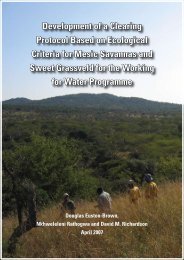Metsi Consultants - DWA Home Page
Metsi Consultants - DWA Home Page
Metsi Consultants - DWA Home Page
You also want an ePaper? Increase the reach of your titles
YUMPU automatically turns print PDFs into web optimized ePapers that Google loves.
Report No 678-F-001<br />
METSI CONSULTANTS: SUMMARY OF MAIN FINDINGS FOR PHASE 1 DEVELOPMENT<br />
MOHALE DAM<br />
Mohale's Hoek<br />
Senqu<br />
6<br />
Quthing<br />
KATSE DAM<br />
7<br />
Senqunyane<br />
8<br />
Lesobeng<br />
Malibamatso<br />
2<br />
Thaba Tseka<br />
5<br />
MASOKU WEIR<br />
1<br />
Senqu<br />
3<br />
4<br />
Matsoku<br />
Qacha's Nek<br />
LEVEL OF IMPACT:<br />
NOT ASSESSED:<br />
Negligible:<br />
Low:<br />
Moderate:<br />
Severe:<br />
Critically severe:<br />
Position of IFR Site<br />
North<br />
0 20 40<br />
Kilometres<br />
Figure 7.1 Broad summary of the likely severity of the biophysical impacts downstream of the LHWP Phase 1<br />
dams under the Design Limitation Scenario.<br />
7.3. SOCIAL IMPACTS<br />
The social impacts associated with the Design Limitation Scenario can be summarised as generally moderate,<br />
except for Reaches 4, 5 and 6, far away from the dams, where they are low. In simple terms this means that<br />
although there would be a reduction in the river resources used by the PAR, this reduction would tend to be less<br />
than 50% for most of the resources used. The notable exceptions to this are fish populations, which are expected<br />
to decline dramatically in the reaches immediately downstream of the dams. There are, however, concerns that, if<br />
the resources that are lost are not compensated for, then the potential for extensive over-utilisation of the<br />
remaining resources would be great, thus leading to their eventual decrease below harvestable levels.<br />
For public health, risk for diarrhoeal diseases is expected to remain moderate along all reaches, except 1, 2 and<br />
3, where it is predicted to become severe. The nutritional risk remains at baseline level throughout, as is the case<br />
for other pathologies, except for a slight increase in the risk of schistosomiasis in reaches close to the dams. It is<br />
likely that the rivers would not present any more of a health risk than they do at present for much of the time, but<br />
there would be occasions when they represent a serious health risk along Reaches 1, 2 and 3. It is difficult to<br />
predict the frequency of these occasions, other than to say that they would be more often than at present, but<br />
probably less often than under the Treaty Scenario. An example could be in summer when temperatures are<br />
high, runoff from rainfall also high (faeces are flushed off the surrounding areas into rivers during times of rain)<br />
but the flow in the rivers is considerably lower than natural, and thus the dilution would be lower. Such water<br />
would have a higher than present level of faecal contaminants and parasites such as Giardia, with a concomitant<br />
increased health risk for those drinking or bathing in the water.<br />
As with the Treaty Scenario, the increase in the incidence of livestock diseases and/or injuries under the Design<br />
Limitation Scenario remains low. However, a moderate increase in nuisance species such as Simulium nigritarse,<br />
a pest of poultry, is predicted.<br />
40

















